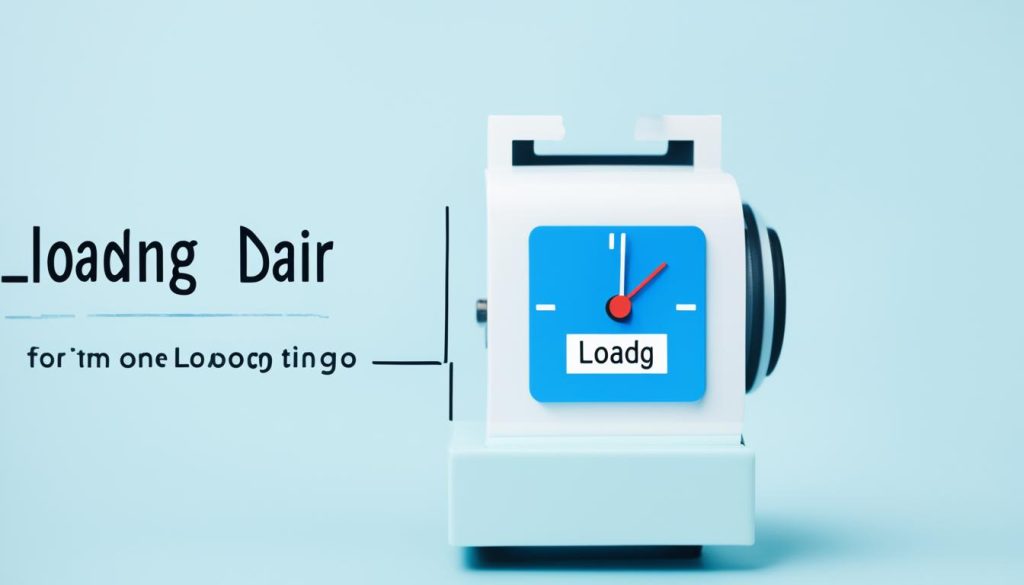Are you tired of seeing your blog visitors bounce away due to slow loading times? In today’s fast-paced digital landscape, making your blog fast is key. In fact, 56% of consumers have made a purchase from a company after reading their blog. But, a 1-second delay in loading can lead to a 7% drop in sales. It’s time to make sure your blog loads quickly to keep your readers interested and your business growing.
Why is Page Loading Speed Important
In today’s fast world, how quickly your website loads is key to its success. Your page speed impacts the user experience and is crucial for your search engine rankings and website performance.
Retain More Traffic
About 40% of users leave a website if it doesn’t load in 3 seconds. This number goes up to 53% for mobile users. A slow website means losing potential customers and visitors who might not come back.
Increase Conversions
Website loading speed affects more than just keeping visitors. It also impacts your website conversions. A 1-second delay can lead to a 7% drop in conversions, making it vital for success.
Search engines like Google look at website performance when ranking sites for both desktop and mobile. Making your website faster can boost your search engine rankings. This means more organic traffic and potential customers for your business.
Today, a fast website is a must-have. By focusing on website loading speed, you can make your user experience better, increase website conversions, and improve your search engine rankings. These are key for your online success.
How to Test Website Loading Speed
Understanding your website’s loading speed is key to improving your blog’s performance. Google’s PageSpeed Insights is a great tool for this. It checks your website’s speed and tells you what slows it down.
PageSpeed Insights gives your website a speed score from 0 to 100. A higher score means faster loading times. It points out areas to improve, like server response time and image optimization. Fixing these can make your website run smoother and give visitors a better experience.
There are more tools for testing website speed, each with its own benefits. These include:
- Pingdom: Offers detailed reports and monitoring.
- GTMetrix: Gives a full website audit with tips for speeding up your site.
- WebPageTest: Simulates different devices and networks to test your site’s performance.
Checking your website’s speed often and using these tools’ advice can make your blog faster and more enjoyable. This leads to more engagement, lower bounce rates, and better performance overall.
How to Reduce Blog Loading Time
Improving your blog’s loading time is key for a better user experience, keeping visitors around longer, and ranking higher in search engines. By using a few simple steps, you can make your blog load faster and make your content more effective. Let’s look at how to make your blog run smoother.
Remove Unwanted Plugins
Start by finding and removing any plugins you don’t need. Plugins add functionality but can slow down your site if not managed well. Check your plugins and delete any you’re not using or that cause problems with your blog.
Look for Plugins that Do More
Instead of using many plugins for different things, look for ones that do several tasks at once. This reduces the number of resources your blog loads, making it faster. Spend time finding plugins that offer many features to help your website load quicker.
Upgrade Your Hosting Plan
The web hosting you choose affects your blog’s speed. If you’re on a shared plan, think about moving to a VPS or dedicated hosting plan. These plans have more resources, like more bandwidth and power, which help your blog load faster as it grows.
| Hosting Plan | Pros | Cons |
|---|---|---|
| Shared Hosting | Affordable, easy to set up | Limited resources, slower performance |
| VPS Hosting | Improved performance, more resources | Higher cost, more technical management |
| Dedicated Hosting | Highest performance, full control | Highest cost, more technical management |
By following these steps, you can make your blog load faster and give your visitors a smoother experience. Remember, making your blog run well is an ongoing task. Keep checking and adjusting to make sure your content loads quickly and efficiently.

Pick a Better Theme
Choosing the right WordPress theme can really speed up your blog. Go for a simple, minimalist theme to cut down on bandwidth and boost speed. As a blogger, aim for themes that don’t have too many fancy features like image sliders or animations.
The Genesis child themes from Studiopress are a great choice. They’re simple, mobile-friendly, and work well with the Gutenberg editor. A lightweight, mobile-friendly theme means your blog loads fast and works well for readers on the move.
- Opt for minimalist WordPress themes to reduce bandwidth and improve loading speed
- Avoid themes with complex visual elements like image sliders and animations
- Consider the Genesis child themes from Studiopress for their streamlined design and Gutenberg compatibility
- Prioritize mobile-friendly themes to cater to the growing number of users accessing your blog on their smartphones and tablets

By picking a theme that supports blog theme optimization, you’re on your way to a fast, user-friendly blog. This will keep your audience interested and coming back for more.
Optimizing Blog Speed
Making your blog load faster is key for a better user experience and better SEO. You can use a content delivery network (CDN) to cut down on delays. Also, caching and optimizing images and media can help.
Using caching techniques can lower the number of requests to your server. This includes browser caching, which saves resources on the user’s device for quicker loads. And server-side caching, which keeps content ready on the server for fast delivery.
Image optimization is also crucial for speed. Compressing images, choosing the right formats, and using lazy or asynchronous loading can make your page load faster. This reduces the file size and speeds up loading.
Also, minification and Gzip compression can shrink your HTML, CSS, and JavaScript files. This makes your blog load faster. Minification removes extra spaces and comments. Gzip compression makes files smaller for quicker transfer.
Improving your server’s response times with lazy and asynchronous loading can also make your blog load faster. Lazy loading delays loading some resources until needed. Asynchronous loading lets important assets load at the same time, making the site faster.
| Technique | Description | Benefits |
|---|---|---|
| Content Delivery Network (CDN) | A network of servers around the world to deliver content quickly to users | Less delay, faster website speed, and better user experience |
| Caching | Keeping often-used content on the user’s device or server for quicker loads | Less server requests, faster page loads, and better website performance |
| Image Optimization | Compressing images, choosing formats, and using lazy/asynchronous loading | Smaller files, faster loads, and better user experience |
| Minification and Gzip Compression | Removing extra spaces and comments, and making files smaller for faster transfer | Smaller files, faster loads, and better website speed |
| Server Response Optimization | Using lazy and asynchronous loading to make servers respond faster | Quicker page loads, less bounce rates, and better user experience |
By using these website speed optimization tips, you can make your blog run better. This will improve user experience and help your search engine rankings.

Tips for Faster Content Creation
Want to make your content creation faster? Try these strategies. Streamline your keyword research, use expert insights, and make a detailed outline. This will speed up the process and keep your content top-notch.
Streamline Your Keyword Research
Good keyword research is key to making great content. Use tools like Semrush’s Keyword Overview and Keyword Magic Tool to find the best keywords for your topic. This ensures your writing hits the mark with your audience.
Find Expert Insights Before Writing
Take time to gather data and quotes from trusted sources before writing. This saves time and adds credibility to your content. It makes your work more impactful.
Create a Detailed Outline
A detailed outline changes the game in content creation. Include keywords, headings, and other important info in your outline. This keeps you on track and makes writing more efficient.

Follow these tips to create content faster without sacrificing quality. The secret is to streamline your workflow, use the right tools, and write with a clear plan.
Write Without Editing First
Many fast and prolific writers have a secret. They don’t edit themselves during the first draft writing. They focus on getting the content down quickly. This way, they can create their initial draft fast.
It’s important to separate the writing process from the editing process. Editing comes later, letting you be creative during the first draft. This method boosts your productivity and helps you avoid getting stuck.
- Embrace the imperfections of the first draft – don’t worry about making it perfect right away.
- Concentrate on getting your thoughts and ideas onto the page without stopping to edit.
- Save the editing and polishing for a separate step after you’ve completed the initial writing process.
By following this approach, you can use the power of writing without editing first. You’ll find a more efficient and productive writing process. Let your creativity shine in the first draft.

Utilize Writing Tools and AI
In today’s fast-paced world, using advanced content creation tools and AI writing assistants can change the game for bloggers and writers. Tools like Semrush’s ContentShake AI and the SEO Writing Assistant are changing how we write blog posts. They help us make the process faster and focus on making the content better.
These AI tools help writers at every step of making content. They can start with a first draft and give insights on SEO, readability, and tone. This makes writing blog posts more efficient and better in quality.
- Use Semrush ContentShake AI to start your writing with a good first draft.
- Help your content get seen more online with the SEO Writing Assistant.
- Make creating social media posts easier with these tools.
By using these AI tools, you can make your blog post writing more efficient and creative. This means you can deliver great content to your readers faster and better.
| Tool | Key Features | Benefits |
|---|---|---|
| Semrush ContentShake AI |
|
|
| SEO Writing Assistant |
|
|
Improve Your Typing Speed
Boosting your typing speed can make you more efficient in creating content. By getting better at typing practice and using typing tools, you can work faster and make your writing smoother.
First, make sure you’re placing your hands correctly on the keyboard. This simple step can make you type faster and more accurately. Then, train your eyes to look at the screen, not the keys. This lets your fingers move freely over the keyboard.
For better typing skills, try using tools like Typing Academy or Typing Club regularly. These sites have fun exercises and challenges that help you get faster and more precise over time.
- Maintain proper hand positioning on the keyboard
- Train your eyes to focus on the screen, not the keys
- Utilize typing practice tools to improve speed and accuracy
Working on your typing speed means you can write faster. This lets you spend more time on the creative and strategic parts of writing.
Try Voice Dictation
In today’s fast-paced world, writers look for ways to make their work easier and faster. Voice dictation tools are becoming more popular. They turn your spoken words into text quickly and efficiently.
Using voice dictation has many benefits. It cuts down the time you spend typing. This lets you think more about your ideas and writing. It makes writing smoother and more creative.
To get the most out of voice dictation, follow some tips. Use a good microphone and find a quiet spot to talk. Speak clearly and keep your outline handy to stay focused. With practice, you’ll see how voice dictation can boost your productivity.
But remember, voice dictation isn’t the final step. The text needs editing and proofreading for accuracy. Edit your work carefully, just like with any other method.
Adding voice dictation to your writing tools can change the game. It saves time and helps you focus on the creative parts of writing. Try it out and see how it can transform your writing.
Optimize Your Editing Process
The content editing process is key to making blog posts top-notch. By making your editing workflow more efficient, you can save time and make your content clearer and more original. It’s also helpful to take breaks between writing and editing to see your work with fresh eyes.
Take Breaks Between Writing and Editing
It’s hard to catch mistakes or areas to improve when you’re too close to your work. Taking breaks helps you step back, clear your mind, and see your text with new eyes. This way, you can spot issues with readability, tone of voice, or originality you might have missed before.
Using a SEO writing assistant like Semrush can also help. These tools check your text for readability, keyword usage, and plagiarism. They give you tips to make your writing better for content editing and SEO.
Reading your content out loud or having it read to you is another great way to find mistakes. It uses more senses to check for awkward phrases, typos, or unclear parts.
Adding these steps to your content editing process makes your workflow better. It also improves the quality of your blog posts. This way, you can share engaging, informative content with your readers.
Use an SEO Checklist
Creating a detailed SEO checklist makes optimizing your blog posts easier. It helps you remember important SEO steps. This includes using your target keywords and writing catchy title tags and meta descriptions.
Your SEO checklist should include many on-page SEO factors. Make sure to format headings correctly, use SEO-friendly URLs, and make sure each sentence is helpful to readers. Also, add internal links and optimize images to boost your blog post optimization efforts.
- Include target keywords throughout the content
- Write compelling title tags and meta descriptions
- Properly format headings (H1, H2, H3, etc.)
- Use SEO-friendly URLs
- Ensure every sentence provides value
- Incorporate internal links
- Optimize images and graphics
With an SEO checklist, editing becomes easier. You can be sure your blog post is ready for search engines and readers.
Leverage Content Delivery Networks (CDNs)
Using a content delivery network (CDN) can greatly improve your website’s loading speed. A CDN stores your site’s content like images, CSS, and JavaScript on many servers worldwide. When a user visits your site, they get the content from a server near them. This cuts down the distance the data travels, making it load faster.
Adding a CDN can make your website run smoother and give users a better experience. With a CDN, your site loads quickly for everyone, no matter where they are. This boosts your site’s speed, helps with search engine rankings, and can lead to more conversions.
Look into different CDN options and pick the one that fits your website best. Choosing a good CDN is a smart move to make your site faster and more reliable. It helps you beat the competition and give your visitors a great experience.

